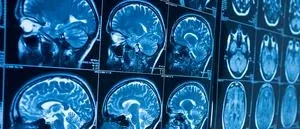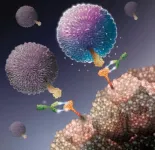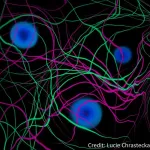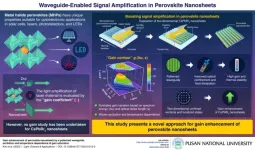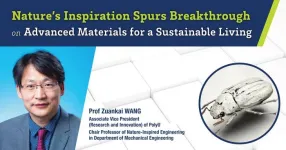(Press-News.org) CLEVELAND—Diagnosing cancer today involves using chemical “contrast agents” to improve the accuracy of medical imaging processes such as X-rays as well as computed tomography (CT) and magnetic resonance imaging (MRI) scans.
But those agents can be expensive, take more time to use and pose potential health concerns.
With a new four-year, $1.125 million grant from the National Science Foundation (NSF), researchers at Case Western Reserve University hope to develop an artificial intelligence (AI) alternative that generates virtual contrast-enhanced images without chemical agents.
Their goal: a safer, quicker and cheaper process using non-contrast images only.
“With this grant, our multidisciplinary team aims to improve the medical-imaging process for clinical staff and patients,” said project leader Shuo Li, an associate professor at the university’s Case School of Engineering (CSE). “Virtual contrast-enhanced imaging could save time and money while continuing to provide the best care to patients.”
Vipin Chaudhary, the Kevin J. Kranzusch Professor and chair of computer and data sciences at CSE; Leonardo Kayat Bittencourt, an associate professor at the School of Medicine and vice chair of innovation in radiology at UH Cleveland Medical Center; and Sree Harsha Tirumani, an associate professor at the School of Medicine and vice chair for clinical research in radiology at UH Cleveland; are co-leading the project. Li, Kayat and Tirumani are all members of the Case Center for Imaging Research.
The challenge
While the use of chemical contrast materials is the gold standard for diagnosing many diseases, increasing numbers of patients, associated costs and potential side effects pose significant challenges. While uncommon, risks to patients include allergic reactions and other short-term adverse reactions.
A new non-chemical imaging technique could reduce such risks while also saving time and money. Such a technique could also help alleviate burdens of potential supply chain issues, such as the global shortage of iodinated contrast media in 2022.
The project
The project leverages the engineering and medical strengths of the research team to develop this new, virtual way of providing valuable diagnostic information to the clinician and patient, but without chemical contrast agents.
The researchers will investigate a new category of image features to inform development and validation of new models for use with MRI scans. Leveraging key technical strengths of AI, the researchers are developing a technique called an AI contrast agent.
The grant is funded through the NSF Smart Health and Biomedical Research in the Era of Artificial Intelligence and Advanced Data Science, an interagency program to support advances in computer and information science, engineering, mathematics, statistics, behavioral and cognitive research for biomedical and public health.
###
Case Western Reserve University is one of the country's leading private research institutions. Located in Cleveland, we offer a unique combination of forward-thinking educational opportunities in an inspiring cultural setting. Our leading-edge faculty engage in teaching and research in a collaborative, hands-on environment. Our nationally recognized programs include arts and sciences, dental medicine, engineering, law, management, medicine, nursing and social work. About 6,200 undergraduate and 6,100 graduate students comprise our student body. Visit case.edu to see how Case Western Reserve thinks beyond the possible.
END
Case Western Reserve researchers land $1.125 million National Science Foundation grant to advance safer, faster and less expensive medical-imaging technology
2024-01-03
ELSE PRESS RELEASES FROM THIS DATE:
PTSD: the brain basis of susceptibility - a free webinar from the Brain & Behavior Research Foundation
2024-01-03
The Brain & Behavior Research Foundation (BBRF) is hosting a free webinar, “PTSD: The Brain Basis of Susceptibility” on Tuesday, January 9, 2024, at 2:00 pm ET. The presenter will be Nathaniel G. Harnett, Ph.D., Director of the NATE Lab at McLean Hospital and Assistant Professor in Psychiatry at Harvard Medical School. Dr. Harnett is also the recipient of a 2021 Young Investigator Grant. The webinar will be hosted by Jeffrey Borenstein, M.D., President & CEO of the Brain & Behavior Research Foundation, and host of the public television series Healthy Minds.
Register today ...
Knowing how clinicians make real-world decisions about drug-drug interactions can improve patient safety
2024-01-03
INDIANAPOLIS — Drug-drug interactions causing adverse effects are common and can cause significant patient harm and even death. A new study is one of the first to examine how clinicians become aware of and process information about potential interactions and subsequently make their real-world decisions about prescribing. Based on these findings, the research team makes specific recommendations to aid clinician decision-making to improve patient safety.
“Drug-drug interactions are very common, more common than a lot of people outside the healthcare system expect. In the U.S., these interactions lead to hundreds of thousands of hospitalizations ...
Immune cell helps predict skin cancer patients’ chances of responding to treatment
2024-01-03
A type of immune cell can help predict which patients may benefit most from cancer immunotherapies, researchers from King’s College London, Guy’s and St Thomas’ Hospital Trust, and the Francis Crick Institute have found.
The study, published today in Nature Cancer, found that a rare type of T cells (a type of immune cell), can help predict the likelihood of whether a patient with advanced skin cancer will be responsive to immunotherapy treatments. The results could also lead to the development of new and more effective treatments for patients with melanoma who do not benefit from current ...
Reprogrammed fat cells support tumor growth
2024-01-03
Mutations of the tumor suppressor p53 not only have a growth-promoting effect on the cancer cells themselves, but also influence the cells in the tumor's microenvironment. Scientists at the German Cancer Research Center (DKFZ) and the Weizmann Institute in Israel have now shown that p53-mutated mouse breast cancer cells reprogram fat cells. The manipulated fat cells create an inflammatory microenvironment, impairing the immune response against the tumor and thus promoting cancer growth.
No other gene is mutated as frequently in human tumors as the gene for the tumor suppressor p53. In around 30 percent of all cases of breast cancer, the cancer cells show mutations or losses ...
Early primates likely lived in pairs
2024-01-03
Primates – and this includes humans – are thought of as highly social animals. Many species of monkeys and apes live in groups. Lemurs and other Strepsirrhines, often colloquially referred to as “wet-nosed” primates, in contrast, have long been believed to be solitary creatures, and it has often been suggested that other forms of social organization evolved later. Previous studies have therefore attempted to explain how and when pair-living evolved in primates.
More recent research, however, indicates that many nocturnal Strepsirrhines, which are more challenging to investigate, are not in fact solitary but live in pairs of males and females. But ...
Foundation laid for improved diagnostic imaging of brain tumors
2024-01-03
Research team draws up criteria for PET-based examinations of malignant brain tumors
Diffuse gliomas are malignant brain tumors that cannot be optimally examined by means of conventional MRI imaging. So-called amino acid PET scans are better able to image the activity and spread of gliomas. An international team of researchers (RANO Working Group), led by scientists from LMU and the Medical University of Vienna, has now drawn up the first ever international criteria for the standardized imaging of gliomas using amino acid PET. It has published its results ...
Magnetic fields in the Cosmos: dark matter could help us discover their origin
2024-01-03
The mini-halos of dark matter scattered throughout the Cosmos could function as highly sensitive probes of primordial magnetic fields. This is what emerges from a theoretical study conducted by SISSA and published in Physical Review Letters. Present on immense scales, magnetic fields are found everywhere in the Universe. However, their origin are still subjects of debate among scholars. An intriguing possibility is that magnetic fields originated near the birth of the universe itself, that is they are primordial magnetic fields. In the study, researchers showed that if magnetic fields are indeed primordial then it could cause an increase in dark matter density perturbations ...
Pusan National University researchers boost signal amplification in perovskite nanosheets
2024-01-03
Perovskite materials are still attracting a lot of interest in solar cell applications. Now, the nanostructures of perovskite materials are being considered as a new laser medium. Over the years, light amplification in perovskite quantum dots has been reported, but most of the works present inadequate quantitative analysis. To assess the light amplification ability, “gain coefficient” is necessary, whereby the essential characteristic of a laser medium is revealed. An efficient laser medium is one that has a large gain.
Scientists have been exploring ways to boost this gain. Now, in a recent study, a team of researchers, led by Professor ...
PolyU researchers develop nature-inspired advanced materials to achieve 99.6% solar reflectivity
2024-01-03
Scientific researchers draw inspiration from nature’s brilliance as they seek to develop transformative solutions to unresolved challenges. Prof. WANG Zuankai, Associate Vice President (Research and Innovation) and Chair Professor of the Department of Mechanical Engineering of The Hong Kong Polytechnic University (PolyU), has meticulously explored the intricacies of nature and made remarkable findings with very significant real-world applications. His recently published research on cooling ceramic successfully translates novel discovery into sustainable applications.
Findings from his research project “Hierarchically structured passive radiative cooling ceramic with high ...
Study: Acetaminophen use during pregnancy linked to language delays in children
2024-01-03
CHAMPAIGN, Ill. — Acetaminophen is considered the safest over-the-counter pain reliever and fever reducer available during pregnancy. Studies have shown that 50%-65% of women in North America and Europe take acetaminophen during pregnancy. A new study from researchers at the University of Illinois Urbana-Champaign explored the relationship between acetaminophen use during pregnancy and language outcomes in early childhood. It found that increasing acetaminophen use was associated with language delays.
The findings are reported in the journal Pediatric ...

